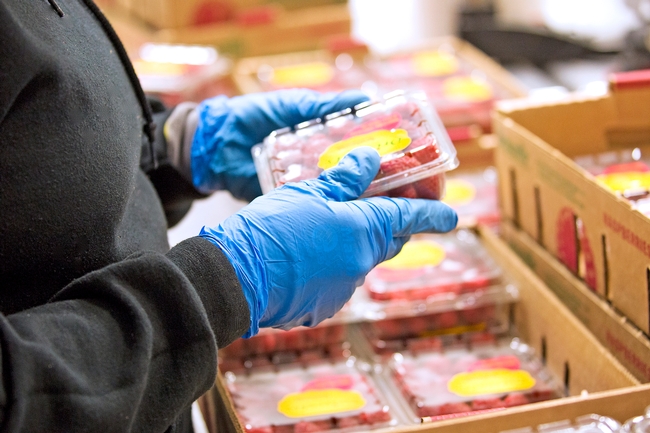Posts Tagged: food insecurity
Study: Government shutdown stressed food assistance program participants
A U.S. federal government shutdown can represent a minor inconvenience, a delay in paychecks, or – for people living in some of the most difficult circumstances – an extended period of hunger and anxiety.
A study published recently in the journal Nutrients provides a unique glimpse into the shutdown experiences of participants in CalFresh – California's name for the federally funded Supplemental Nutrition Assistance Program (formerly known as food stamps). Currently, about 42 million people participate in SNAP across the U.S.
In focus groups conducted in 2019 with 26 low-income CalFresh participants from four diverse California counties, participants shared how the 2018-19 federal government shutdown affected their SNAP benefits, their perception of the program and their faith in government.
One of the immediate effects of the 2018-19 shutdown was that February CalFresh benefits were distributed in January. And while that meant program participants saw extra benefits that month, they then had to wait 40 to 44 days until the March issuance – much longer than the usual 28 to 31 day cycle.
“What we saw with this study is that this extended lag in benefit receipt from January to March was devastating,” said Wendi Gosliner, senior researcher and policy advisor at the Nutrition Policy Institute of UC Agriculture and Natural Resources, and an author of the study funded by UC ANR.
She recalled one participant who, despite having a gastrointestinal issue that requires a special diet, had to eat canned food from the food bank that made her sick – rather than go hungry while waiting for her March benefits. Others described cascading financial challenges after using rent money for food in February, or going into debt to pay for food and getting behind on other expenses.
The study also chronicles the experiences of a woman who was anguished to hear the suffering of her daughter, also a CalFresh participant: “She called me several times crying, ‘Ma, I don't – we don't have enough food. What am I going to do…? You know, I can't afford to this and this and this.' And I can't help her.”
For individuals grappling with food insecurity, the stress of feeding their families was compounded by the uncertainties of the government shutdown. And while many participants exercised their agency and resourcefulness in coping with the situation, they also felt a degree of powerlessness amid the “confusion and craziness,” as one person put it.
“No one knew how long that shutdown was going to last; no one knew if the March benefits were going to be paid,” Gosliner said. “And as we learned, there were all kinds of stories circulating out there about what was going on with the uncertainty – a lot of people didn't have the information about what was actually happening.”
Some participants, seeing the “double benefit” in January 2019, thought that it was the last-ever distribution and that SNAP was ending. Others described being unable to get in touch with the CalFresh agency to get their questions answered about the benefits. Most participants had not heard about the disrupted benefit schedule before receiving the benefits. As a result, many people in the focus groups shared that their overall faith in government had been shaken.
Improving customer service, boosting benefit levels and adjusting eligibility and benefit formulas to reflect high cost-of-living and expenses related to working were three recommendations that came from the focus group participants.
A fourth recommendation tackles the shutdown issue head-on: Don't let it happen again.
“Congress should do absolutely everything in their power to be sure that the program operates on the usual time schedule – even if the government is shut down,” Gosliner said.
In the context of the global pandemic, when financial and social inequities and physical and mental health disparities have been laid bare, ensuring access to healthful food is even more important. And with studies showing that hospitalizations increase with longer lags between SNAP distributions, Gosliner said the “absolute last thing” the overburdened health system needs is more people in emergency departments seeking acute care.
“It's the worst time to be having people who need money to feed their families face additional insecurity,” she said. “It's critically important that Congress acts to be sure that there is not any disruption in benefits.”
The authors of the study, “Participants' Experiences of the 2018–2019 Government Shutdown and Subsequent Supplemental Nutrition Assistance Program (SNAP) Benefit Disruption Can Inform Future Policy,” are Wendi Gosliner, Wei-Ting Chen, Cathryn Johnson, Elsa Michelle Esparza, Natalie Price, Ken Hecht and Lorrene Ritchie.
The study can be found online at https://www.ncbi.nlm.nih.gov/pmc/articles/PMC7353319.
Food insecurity and childhood obesity: Is there a connection?
A well-nourished population requires that all members of society have access to sufficient amounts of nutritious food. Unfortunately, food insecurity continues to be a staggering problem throughout the world with negative consequences in terms of health and well-being.
In the United States, millions of households, an estimated 1 in 8 Americans, lack access to enough food. Children growing up in food insecure households face many challenges, such as behavioral problems, lower academic achievement, disrupted social interactions and poor health. The prevailing belief is that children living in a food insecure environment are at greater risk of undernutrition, not obesity. Although this may be true in some cases, food insecurity and childhood obesity also coexist.
Because childhood food insecurity may increase obesity risk later in life, it is important to better understand the relationship between food insecurity and children's obesity, and how it varies by demographic characteristics in the United States.
A recent study published in the September 2019 issue of The Journal of Nutrition assessed the relationship between household food insecurity and child adiposity-related outcomes. This included variables such as body mass index, waist circumference and diet outcomes. The study, conducted by Lauren Au, a researcher at UC Agriculture and Natural Resources' Nutrition Policy Institute, and colleagues examined associations by age, sex, and race/ethnicity. Data collected in 2013-2015 from 5,138 U.S. schoolchildren ages 4-15 years old from 130 communities in the cross-sectional Healthy Communities Study were analyzed.
Household food insecurity was self-reported using a two-item screening instrument and dietary intake was assessed using a food frequency questionnaire. Information on dietary behaviors, physical activity and demographics was collected. To assess adiposity, children's weight, height and waist circumference were measured.
Study results support an association between food-insecure households and measures of adiposity. Children from food-insecure households had high body mass index, waist circumference, greater odds of being classified as overweight or obese, consumed more sugar from sugar-sweetened beverages, and less frequently ate breakfast and dinner with family compared to children from food-secure households. When examined by age groups, significant relationships were observed only for older children, however, results did not differ according to sex or race/ethnicity.
These results suggest that household food insecurity is associated with higher child adiposity-related outcomes and several nutrition behaviors, particularly among older children. Clearly, further research is needed to better understand the complexities of food insecurity, childhood obesity, and future health outcomes.
Read the full open access article.
This research was supported by the National Heart, Lung, and Blood Institute, part of the National Institutes of Health.



